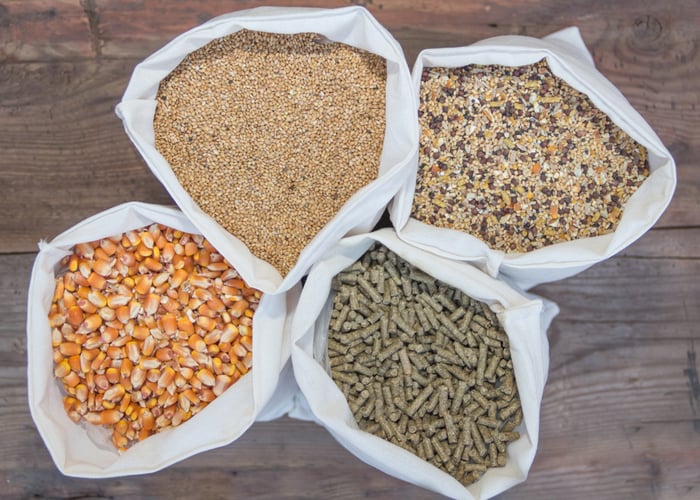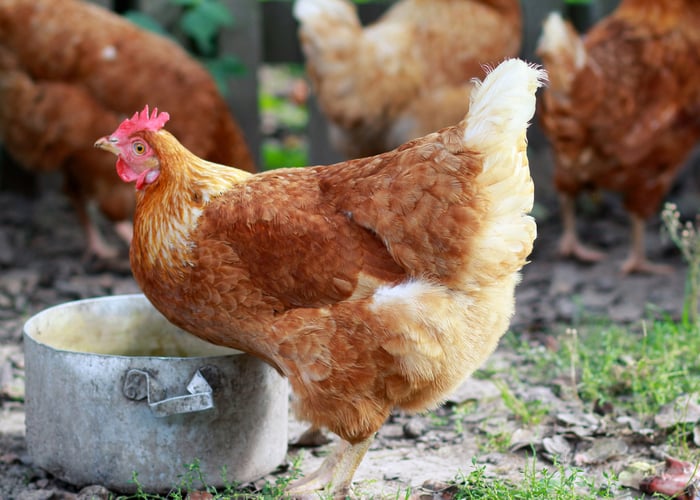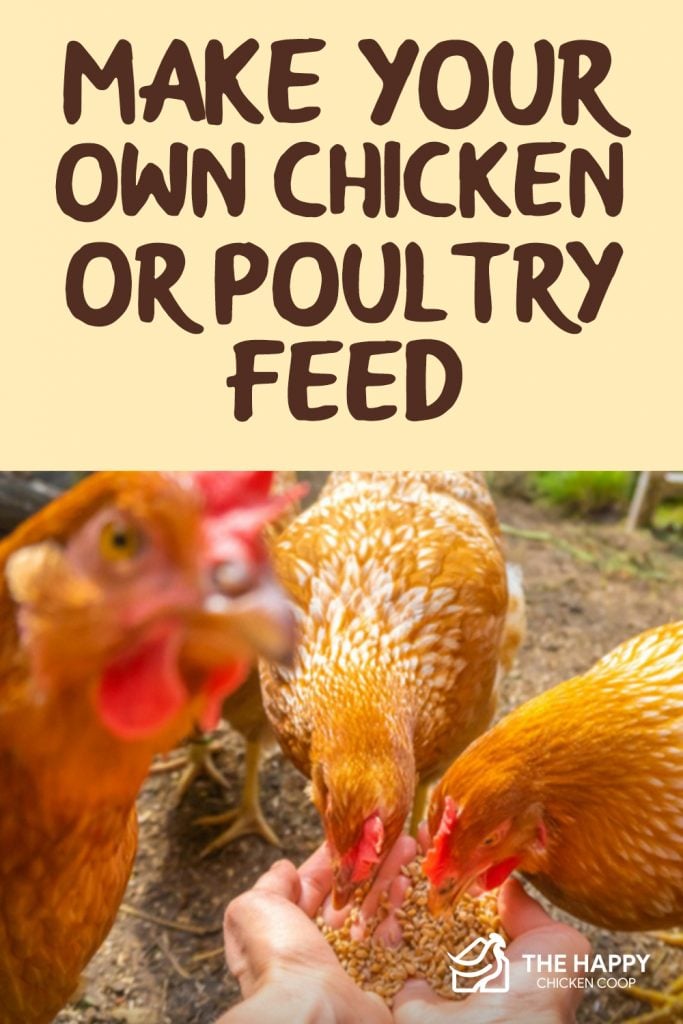Justin Rhodes Homemade Chicken Feed Recipe
Around 80% of chicken food is composed of grains. If you want to save some bucks and make sure your bird's food is organic, creating a DIY feed is the way to go. Are you wondering how to make your chicken or poultry feed?
It's not a backbreaking task, but to make sure you will meet your chicken's nutritional requirements, we curated a guide about:
- How to make your own chicken feed that will satisfy their needs
- The ingredients you must choose for your poultry feed
- And the pros and cons of making a DIY chicken feed
If you're one of the many people switching to organic chicken feed options and hands-on in customizing their bird's food, you'll benefit from the recipe we'll share below.
So, get your grains and feeder ready.

How to Make Your Own Chicken or Poultry Feed
There is no perfect chicken feed. But you can formulate one that meets your poultry bird's nutrient requirements. With that said, you need to consider your bird's dietary needs.
And that's what we're going to discuss before getting the ingredients.
Nutritional Requirements for Chicken
Your homemade chicken feed mix must have the following nutrients to make sure the needs of your chickens are met:
1. Protein
Proteins are huge molecules of 20 different amino acids arranged in a specific order.
A bird may produce 10 of these amino acids from other compounds. But the remaining ten must be found in the proteins of their feed items to make all of the chicken proteins they require to live and grow.
Your chicken can get high amounts of protein from the following:
- Alfalfa meal
- Corn
- Field peas
- Wheat
- Crab meal
- Duckweed
- Quinoa
- Spelt or hulled wheat
- Wild rice
- Amaranth seeds
- Nyjer seeds
- Hemp seeds
- Shelled peanuts
- Insects like Mealworms
You may also feed your chicken with lower protein grains to balance the higher proteins. These are also less expensive than the foods above.
- Rye
- Barley
- Buckwheat
- Sorghum (milo)
Amino acids
One of the reasons why chickens need protein is because they can't produce the amino acids called Methionine and Lysine on their own. So, they need to get them from their diet.
Methionine aids in increasing muscle mass, feather development, and egg production. On the other hand, Lysine helps ensure balanced nutrition and better flock performance.
Your chicken can get amino acids from the following food:
- Wheat
- Flaxseed
- Methionine
Other sources of Methionine include:
- Fish meal
- Corn gluten meal
- Sesame hulls
Note: These three are high in Methionine, but too much oatmeal can make poultry products taste fishy. Also, sesame hulls must be limited to 8% in broiler starter and 14% in layer diets.
2. Fats
Triglycerides are dietary fats made up of three fatty acids connected to a glycerol backbone.
These fats usually come in the form of animal fats or vegetable oils are a source of calories in a bird's diet.
They help increase the handling qualities, palatability, and pellet quality of a feed and aid in absorbing critical fat-soluble vitamins.
Omega-3 fatty acids are abundant in ingredients like:
- Flaxseed
- C amelina
- Fish meal
3. Carbohydrates
Carbohydrates are the fuel source needed by all cells and are used as a rapid energy source and the most crucial part of a poultry diet.
On a feed label, cellulose and other complexes, indigestible carbohydrates are labeled as "crude fiber."
While these molecules may play a crucial function in intestinal health, too many of them might stunt a bird's growth. And it might make them more susceptible to digestive issues. Therefore, it has to be just at the right level.
Carbohydrates can be derived from grains such as:
- Corn
- Wheat
- Sorghum
- Barley
- Rye
- Millet
- Digestible starch (like cellulose)
4. Vitamins
Like any other animal, chickens need vitamins to absorb the other nutrients properly. As for these birds, these are the essential vitamins for them:
- Vitamin A is for healthy vision and reproductive health.
- Vitamin D is used in bone development and calcium metabolism.
- Vitamin E is a biological antioxidant.
- Vitamin K is required for proper blood clotting.
- Vitamin B1 aids in carbohydrate metabolism.
- Riboflavin or Vitamin B2 helps the chicken metabolize fats and protein and produce energy.
- The water-soluble B-complex vitamins are involved in all body's energy metabolic reactions.
You may notice that Vitamin C is missing from the list. Well, that is because chickens can produce their own Vitamin C. So, there is no need to supplement their diet.
Treats that are rich in vitamins and minerals include:
- Oats or barley
- Fruits or berries
- Leafy greens
- Vegetables
5. Minerals
Chickens need minerals like calcium, phosphorus, and magnesium for bone development. They also benefit from electrolytes such as sodium, potassium, and chlorine because they help balance the cells.
Since grains are often deficient in critical minerals, supplementation is required for optimal performance. Some of the most crucial minerals in a chicken's body are calcium, phosphorus, and salt.
Calcium is vital for laying hens' skeletal development and eggshell creation, and they can be found in:
- Aragonite or feeding limestone
- Oyster shell
- meat and bone meal
Other mineral sources:
- Crab meal
- Kelp
- Cultured yeast
Check out the table below to have an overall insight into your chicken's dietary needs.
| Typical Nutrition Concentrations for Various Types of Poultry | |||||||
| Protein (%) | Methionine (%) | Lysine (%) | Calcium (%) | Avail. Phos. (%) | Fat (%) | Fiber (%) | |
| Broiler (meat bird) | |||||||
| Starter (1-3 weeks) | 22 | 0.50 | 1.30 | 0.95 | 0.45 | 5.0 | 2.5 |
| Grower (4-6 weeks) | 20 | 0.45 | 1.15 | 0.90 | 0.40 | 5.5 | 2.5 |
| Finisher (7+ weeks) | 18 | 0.5 | 0.95 | 0.85 | 0.35 | 6.0 | 2.5 |
| Pullet (young hen) | |||||||
| Starter (1-6 weeks) | 20 | 0.45 | 1.10 | 1.00 | 0.45 | 4.0 | 3.0 |
| Grower (7-18 weeks) | 17 | 0.35 | 0.80 | 0.95 | 0.40 | 4.0 | 3.0 |
| Egg Laying Hen | |||||||
| In production (19+ weeks) | 16-18 | 0.35-0.45 | 0.75-0.85 | 3.50-4.50 | 0.35-0.50 | 4.0 | 3.0-4.0 |
| Note: Since Broilers have higher dietary needs, pre-made commercial feeds that provide complete nutrition and support their fast growth are the best for them. | |||||||
Now that you're aware of your chicken's dietary requirements, let's move on to the exciting part, where we'll answer how to make your own chicken food.

What are the Ingredients For Chicken Feed?
Let's assume you're making a 20-pound batch combining different grains and seeds, which you can find online or at your local store.
Here's a simple DIY poultry feed formula you can follow.
- 30% Corn — 6 pounds
- 30% Wheat — 6 pounds
- 20% Peas — 4 pounds
- 10% Oats — 2 pounds
- 10% Fish Meal — 2 pounds
- Add-ons to boost their health:
- 2% Poultry Nuti-balancer —0.4 pounds
- Free choice Kelp & Aragonite
Note: Chicken feed may vary depending on the breed. The formula above is a basic guide you can follow. Your vet may have suggestions to customize the feed for your chicken. So, it's best to visit your vet first.
How to Mix Your Own Chicken Feed:
This is pretty given but here are some mixing tips for you.
1. Combine the main ingredients in a large container first.
2. Then, mix it thoroughly before adding the supplements or boosters.
3. Mix it again, and it's ready to feed to your chickens.
How to Make Your Own Chicken Feed for Layers
As for layer chickens, they have higher calcium needs to make their eggshells stronger and have better egg production. But the formula below is versatile. You can use it for other chickens in your flock too. Here's how to make your own layer feed.
Ingredients for DIY chicken feed for layers:
- 10 pounds cracked corn
- 10 pounds split peas
- 8 pounds wheat
- 1-1.5 pounds oats (do not exceed 15%)
- 1-1.5 ounces flaxseed
- 1-1.5 ounces kelp powder
- Crushed eggshells (optional)
- 1 ounce salt (not for free-range chickens)
How to Make Your Own Chicken Feed for Young Chicks
Your baby chicks need at least 22% protein in their diet, so you have to ensure they receive enough nutrients. Since they can't eat large grains, you also need to mash them to make them easier to ingest.
Many hand-operated grinders in the market will help you with this task. But if you have a large chicken flock and a handful of chicks, you may need to have a commercial, heavy-duty feed mill.
Here are the ingredients for a DIY chick feed:
- 5 pounds of wheat
- 5 pounds of oats
- 5 pounds of split peas
- 2-4 ounces of fishmeal
- 4-8 ounces of sunflower seeds
- 2-4 ounces of kelp meal
- 1-2 tablespoons of brewer's yeast
Things You Shouldn't Forget When Making Poultry Feed
Water
Water is an essential nutrient that you should not overlook when making your own chicken feed.
That is because poultry feed contains 10% moisture while their meat usually has 65 to 70% moisture. Their eggs, on the other end, have 75% moisture.
These figures show why birds need plenty of clean drinking water.
In addition to that, birds drink about twice the amount they eat, and they won't eat if they can't drink. Water also helps them cool down when they're panting, sweating, or under stress.
Grit
Some commercial feeds contain probiotics and prebiotics that aid in digestion. But you may not have those ingredients when making your homemade chicken feed. Good thing you can add grit as an alternative.
Grit is usually limestone or granite gravel that helps the gizzard or gastric mill of the bird in grinding food.
The mixing process should be similar to the other recipes. But before making this recipe, here are some reminders for you regarding this chick feed's ideal consistency.
Types of Chicken Feed Textures
When preparing your own chicken feed, you need to remember the three types of textures and the age range they're appropriate to feed to. Here are the three feed texture terms used in commercial feeds.
1. Mash
This feed type is the most suitable for baby chicks with tiny beaks since it has the consistency of potting soil. You can start feeding your little chicks with this from birth until they turn 8 to 12 weeks old.
2. Crumble
Now this feed has larger pieces and coarser, and it's the halfway point between mash and pellets. You may feed your chicken with this when they pass the 12-week mark.
3. Pellets
This feed is larger than whole grains and more challenging to digest, so it's best to serve chickens 18 weeks old and above.

Advantages and Disadvantages of DIY Chicken Feed
Seeing how many things should be considered when making a chicken feed may leave you thinking if it's worth spending your time on. But you can highly benefit from going the homemade chicken feed route.
Why Make Your Own Poultry Feed
Here are the advantages of making your own feed:
You can save a considerable amount
It's not surprising if one of the main reasons you want to know how to make your own chicken feed is that commercial feeds are hefty.
We can't deny that fact, and if you're just starting in homesteading, buying commercial feeds can be burdensome in your pocket.
But if you'd buy large quantities of grains and ingredients, you'll see that it can be more cost-effective than purchasing a pre-made chicken feed.
You know the ingredients.
If you're the type of person who wants to know the littlest details about your chicken's food to ensure they're safe and healthy, making your own poultry feed is the way to go.
You can find non-GMO ingredients in your local store for your organic chicken feed recipe.
Your chicken will benefit more if you provide a soy-free diet since it's among the most genetically-modified foods in the world. It may cause vitamin deficiencies and hormone disruptions. That's why it's best to avoid GMOs.
The nutrients were preserved.
Premade commercial chicken feeds like pellets and crumbles provide complete and balanced nutrition. But they undergo cracking, mashing, pressing, and heating. And it makes the grains go stale and causes them to lose nutritional value.
Downsides of Making Your Own Poultry Feed
Of course, DIY-ing your chicken's food comes with some sacrifices and drawbacks, and here are some of them.
Time-consuming
Making your own chicken feed can consume a large chunk of time, especially if you're mixing many ingredients in large quantities.
Looking for ingredients is difficult .
Sourcing the ingredients is a real challenge, especially if you're looking for organic grains. It's also time-consuming.
But if there's a feed store in your area that can get the ingredients from companies like New Country Organics, that's a lot of burdens lift off your shoulder.
Tip on How to Cut the Cost of Your Chicken Feed
If you want to save chicken feed and cut the cost, free-ranging your chicken will help. Of course, you need to have enough acreage and fresh pasture. But if you'll raise your chicken on a pasture, they'll easily find some insects, bugs, grasses, and weeds that can fill their stomach.
However, there are also downsides to raising chickens in a pasture. They might ingest hazardous things like nails, screws, staples, and styrofoam. So, you need to check your pasture area and get rid of the hazards.
And even if your chickens are free-ranging, they still need supplemental feed, especially during winter when grasses stop growing and the temperature drops down. So, knowing how to make your own chicken or poultry feed is still necessary.
FAQ About Making Your Own Poultry Chicken Feed
We also compiled the common questions asked about chicken or poultry feed to help you grasp the reality of homemade poultry foods.
Is it cheaper to make your own chicken feed?
Creating a DIY chicken feed is usually a slightly cheaper option than buying pre-made feed if you're going to buy the ingredients in bulk and larger batches.
However, you have to know that the initial cost can be high, especially if you choose organic products in making your own chicken feed.
How do you make a simple poultry feed?
Here's a simple homemade chicken formula you follow:
- 6 pounds corn (30%)
- 6 pounds wheat (30%)
- 4 pounds peas (20%)
- 2 pounds oats (10%)
- 2 pounds fish meal (10%)
If you want to add a boost of minerals like calcium, you can add Aragonite or oyster shell, or kelp powder.
How do you make high-quality chicken feed?
Making layer feeds involve mixing grains such as cracked corn, wheat, split peas, oats, and kelp powder. However, layers have higher calcium needs, so you may also add a fish meal or crushed oyster shells as an additional calcium supplement.
This recipe is versatile and usable for chicks, but it would be best to add brewer's yeast to help support the baby chick's growth.
What is the best poultry feed?
The best chicken feeds include Scratch and Peck Feeds, Manna Pro, Hiland Naturals, and Prairie's Choice Non-GMO Backyard Chicken Feed. Kalmbach, Brown's layer booster, and Kaytee Chicken Starter Grower Crumble are also good options, but they would vary depending on your chicken's age and nutritional needs.

Final Takeaways on How to Make Your Own Chicken or Poultry Feed
So that's how to make your own chicken or poultry feed!
Basically, you just need to choose good quality grains such as corn, oats, peas, wheat, and fish meal. You can also add calcium supplements like Aragonite or oyster shells for layers.
But as for your tiny chicks, they need brewer's yeast to support their growth aside from calcium.
It would also help if you'd add grit in their food so that they can digest the food easily. Don't forget to provide water to prevent them from choking.
So, are you now ready to make your own chicken or poultry feed? Share your experience in the comment section below. We can't wait to hear from you.
READ NEXT: The Complete Guide to Chicken Feed
WANT TO SHARE THIS?

attawayaturneve69.blogspot.com
Source: https://www.thehappychickencoop.com/make-your-own-chicken-or-poultry-feed-diy-chicken-feed/
0 Response to "Justin Rhodes Homemade Chicken Feed Recipe"
Post a Comment